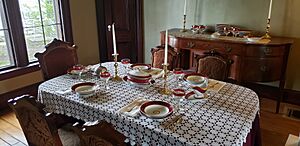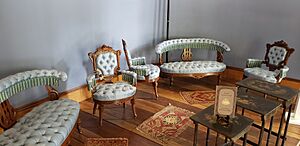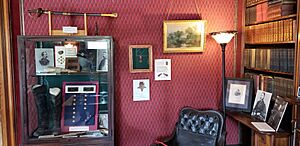Joshua L. Chamberlain Museum facts for kids
The Joshua L. Chamberlain Museum was once the home of a very important person named Joshua L. Chamberlain. He was a brave general in the American Civil War, the president of Bowdoin College, and even the Governor of Maine. He lived in this house for more than 50 years!
Today, the house is a museum. It is located in Brunswick, Maine, at the corner of Maine and Potter Streets. You can visit it during certain times of the year. The museum is being carefully restored to look just like it did when Chamberlain lived there.
Contents
The Story of the House
Early Days: 1824 to 1859
The first part of this house was probably built by Jesse Pierce. He bought the land in 1824. The house was a "Greek Revival" style, which means it looked a bit like ancient Greek temples.
After Jesse Pierce, the house had several owners. One important person who rented rooms here was Henry Wadsworth Longfellow. He was a famous poet. He lived in the house with his first wife while he taught at Bowdoin College.
In 1859, Joshua L. Chamberlain bought the house. He paid $2,100 for it. He had been renting an apartment in the building for two years. He lived there with his wife, Frances Caroline Adams, and their two children.
Chamberlain's Home: 1859 to 1983
After the Civil War, in 1867, Chamberlain and his family made a big change. They sold part of their land. Then, they moved the entire house down the street! It was placed at the corner of Maine and Potter streets, facing a new direction.
After the move, the house got some new looks. They added decorative trim that looked like castle walls. The chimneys were also decorated with different kinds of crosses.
When Chamberlain became president of Bowdoin College in 1871, he decided to stay in his own home. He wanted to make it grand enough for important guests. So, he used equipment from local shipyards to lift the entire house 11 feet into the air! A whole new floor was built underneath it. This new first floor had a "Gothic" style, but also mixed in "Italianate" and "Greek Revival" designs.
In the 1890s, Chamberlain added a "Gothic" porch to the back of the house. Later, in 1907, he had the castle-like decorations removed.
After Chamberlain passed away in 1914, his daughter, Grace Allen, inherited the house. She rented out rooms until she died in 1937. Her daughter, Rosamond Allen, then owned it. In 1939, Rosamond sold the house to Emery Booker. He divided the building into seven apartments, mostly for college students.
In 1983, the Pejepscot Historical Society bought the house for $75,000. They opened it as a museum in 1984.
Many famous people visited Chamberlain's home. These included Civil War generals like Ulysses S. Grant, William Tecumseh Sherman, and Philip Sheridan. Other important visitors included politicians like Charles Sumner and James G. Blaine.
Visiting the Museum
The Pejepscot Historical Society runs the museum today. You can take guided tours from late May (Memorial Day weekend) until early October (Columbus Day weekend).
On the tour, you can see many rooms. These include the Dining Room, the Library, and the Formal Parlor. You can also see special items that belonged to Chamberlain. These include the boots he wore at the battle of Gettysburg. You can also see his special chair and desk from when he was governor. There's even the minié ball bullet that almost ended his life during the Second Battle of Petersburg.
In the winter of 2013-2014, the house had a problem. Very cold weather caused the water pipes to freeze and burst. Water poured into the first floor. This caused damage to ceilings and walls in the parlor and dining room. Some old furniture was also damaged. This event helped the Maine State Museum create a better plan for emergencies. They formed a group called the Cultural Emergency Resource Coalition (CERC).





